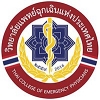The modified rapid emergency medicine score: A trauma triage tool to predict in-hospital mortality in Hatyai hospital
Keywords:
Mortality prediction, Scoring system, modified Rapid Emergency Medicine Score (mREMS), Trauma Score – Injury Severity Score (TRISS)Abstract
Introduction : The effective trauma care would reduce mortality rate which associate with injury severity. An accurate trauma severity score has advantage to prioritize responses and resources in emergency room. Currently Hatyai hospital is using TRISS to predict probability of survival which need many variables to calculate and difficult to evaluate in emergency room. We aim to test a novel trauma triage tool, the modify Rapid Emergency Medicine Score (mREMS), since It can predict in-hospital mortality rate compare to TRISS to evaluate severity of traumatic patient.
Objectives : The objective was to test mREMS accuracy as a predictor of in-hospital mortality when compared to the Trauma Score – Injury Severity Score (TRISS).
Methods : The research comprised validating the modified REM score retrospectively in Hatyai hospital that included 2,104 patients admitted with trauma in 2017. The discriminate power of mREMS was compared to TRISS using the area under the receiver operating characteristic curve (AUC).
Results : Higher mREMS was associated with increased mortality (p-value < 0.0001). The mREMS with an AUC of 0.934 (95% CI: 0.898–0.971) was demonstrated to be higher than RTS (AUC 0.888 [95% CI: 0.816–0.961]) and ISS (AUC 0.8790 [95% CI 0.817–0.941]) but lower than TRISS (AUC 0.940 [95% CI: 0.902–0.978]) in predicting in-hospital mortality in Hatyai hospital.
Conclusions : In the trauma patients, mREMS is an accurate predictor of in-hospital mortality. Simple and objective, mREMS may hold value in the pre-hospital and emergency room setting in order to guide trauma team responses.
References
สำนักนโยบายและยุทธศาสตร์ กระทรวงสาธารณสุข. สถิติสาธารณสุข พ.ศ.2558 Public Health Sta-tis-tics A.D.2015. กรุงเทพฯ: โรงพิมพ์สามเจริญพานิชย์(กรุงเทพ) จำกัด,2016.P79-80.
Ernest E. Moore, David V. Feliciano, Kenneth L. Mattox. Chapter 2 Epidemiology Trauma. 5th edition : McGraw Hill, 2004. P 57-84
F Rhee P, Joseph B, Pandit V, Aziz H, Vercruysse G, Kulvatunyou N, et al. Increasing trauma deaths in the United States. Ann Surg. 2014;260(1):13-21.
Velopulos CG, Enwerem NY, Obirieze A, Hui X, Hashmi ZG, Scott VK, et al. National cost of trauma care by payer status. J Surg Res 2013;184:444-9.
Meddings DR. Trauma and emergency care: an update on WHO's activities. Inj Prev 2007;13:143.
MacKenzie EJ, Rivara FP, Jurkovich GJ, Nathens AB, Frey KP, Egleston BL, et al. A national evaluation of the effect of trau-ma-center care on mortality. N Engl J Med 2006,354:366-78.
No authors listed. Rating the severity of tis-sue damage: I. The abbreviated scale. JAMA 1971;215:277-80.
Schluter PJ, Nathens A, Neal ML, Goble S, Cameron CM, Davey TM, etal. Trauma and injury severity score (TRISS) coefficients 2009 revision. J Trauma 2010;68:761-70.
Champion HR, Sacco WJ, Copes WS, Gann DS, Gennarelli TA, Flanagan ME. A revision of the trauma score. J Trauma 1989;29:623-9.
Baker SP, O'Neill B, Haddon Jr.W, Long WB.The injury severity score: a method for describ-ing patients with multiple injuries and evaluating emergency care. J Trauma 1974;14:187-96.
Miller RT, Nazir N, McDonald T, Cannon CM. The modified rapid emergency medicine score: A novel trauma triage tool to predict in-hospital mortality. Injury. 2017;48(9):1870-7.
Olsson T, Terent A, Lind L. Rapid Emergency Medicine score: a new prognostic tool for in-hospital mortality in nonsurgical emergency department patients. J Intern Med 2004;255:579–87

Downloads
Published
How to Cite
Issue
Section
Categories
License
บทความที่ได้รับตีพิมพ์ในวารสารเวชศาสตร์ฉุกเฉินแห่งประเทศไทย ถือเป็นเป็นลิขสิทธิ์ของ วิทยาลัยแพทย์เวชศาสตร์ฉุกเฉินแห่งประเทศไทย
กรณีที่บทความได้รับการตีพิมพ์ในวารสารเวชศาสตร์ฉุกเฉินแห่งประเทศไทยแล้ว จะตีพิมพ์ในรูปแบบอิเล็กทรอนิกส์ ไม่มีสำเนาการพิมพ์ภายหลังหนังสือเผยแพร่เรียบร้อยแล้ว ผู้นิพนธ์ไม่สามารถนำบทความดังกล่าวไปนำเสนอหรือตีพิมพ์ในรูปแบบใดๆ ที่อื่นได้ หากมิได้รับคำอนุญาตจากวารสารเวชศาสตร์ฉุกเฉินแห่งประเทศไทย



